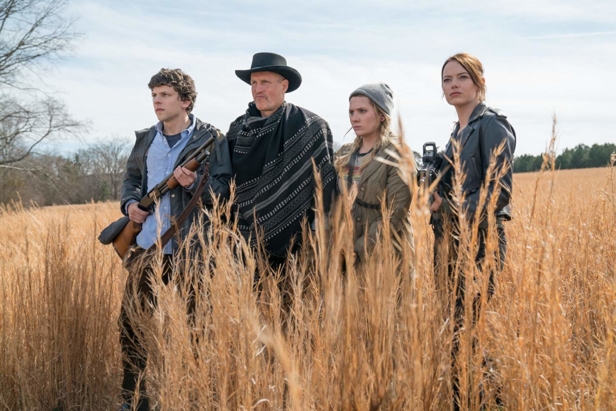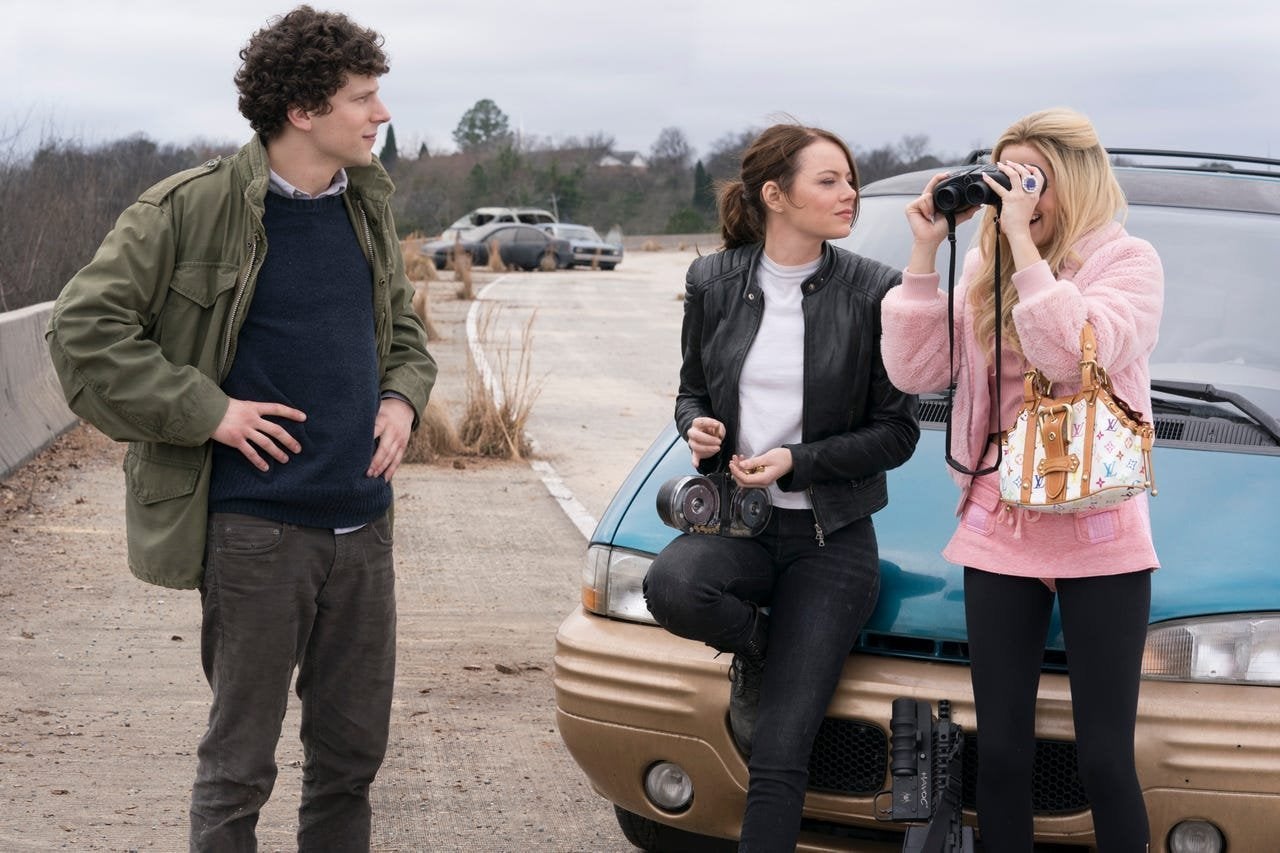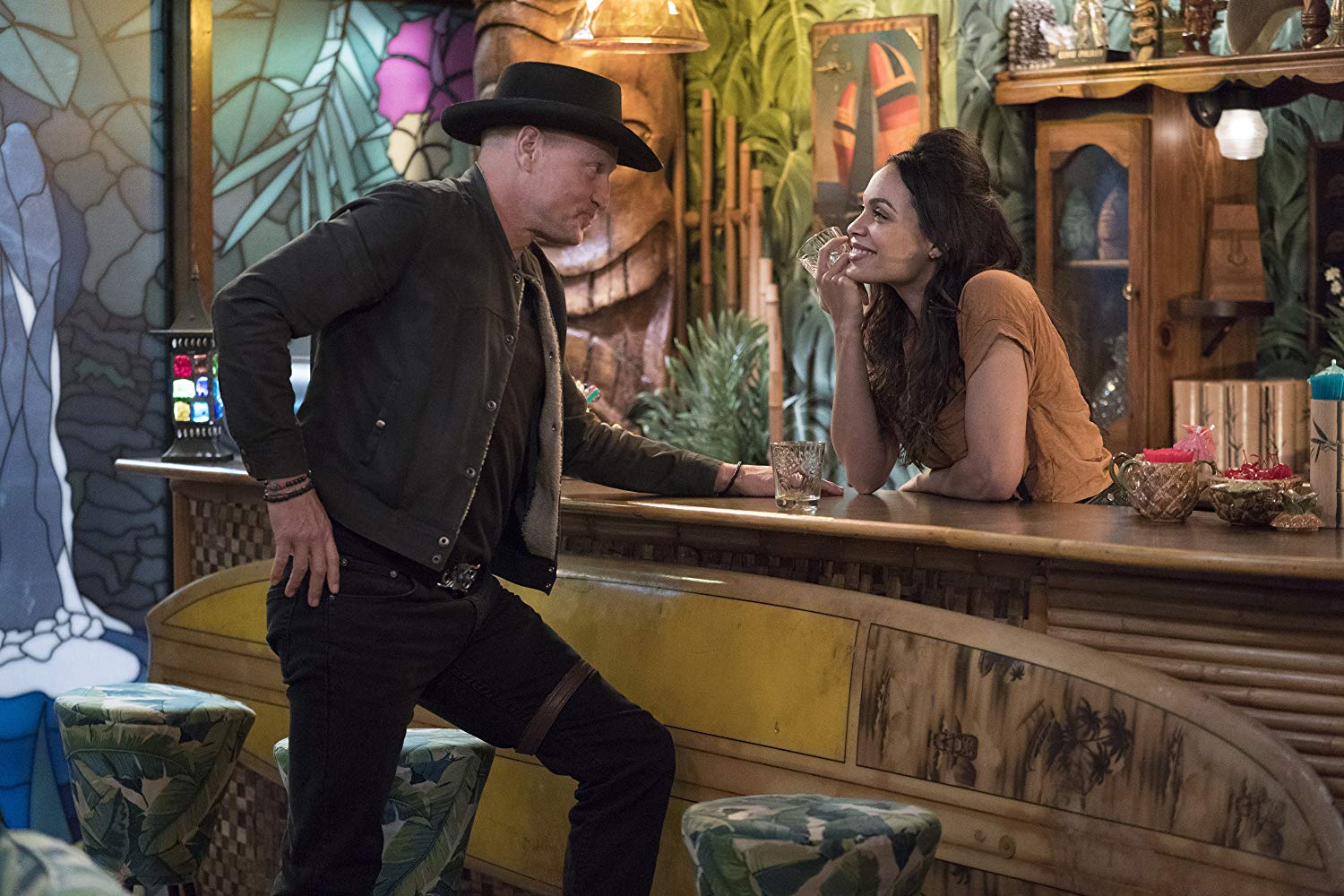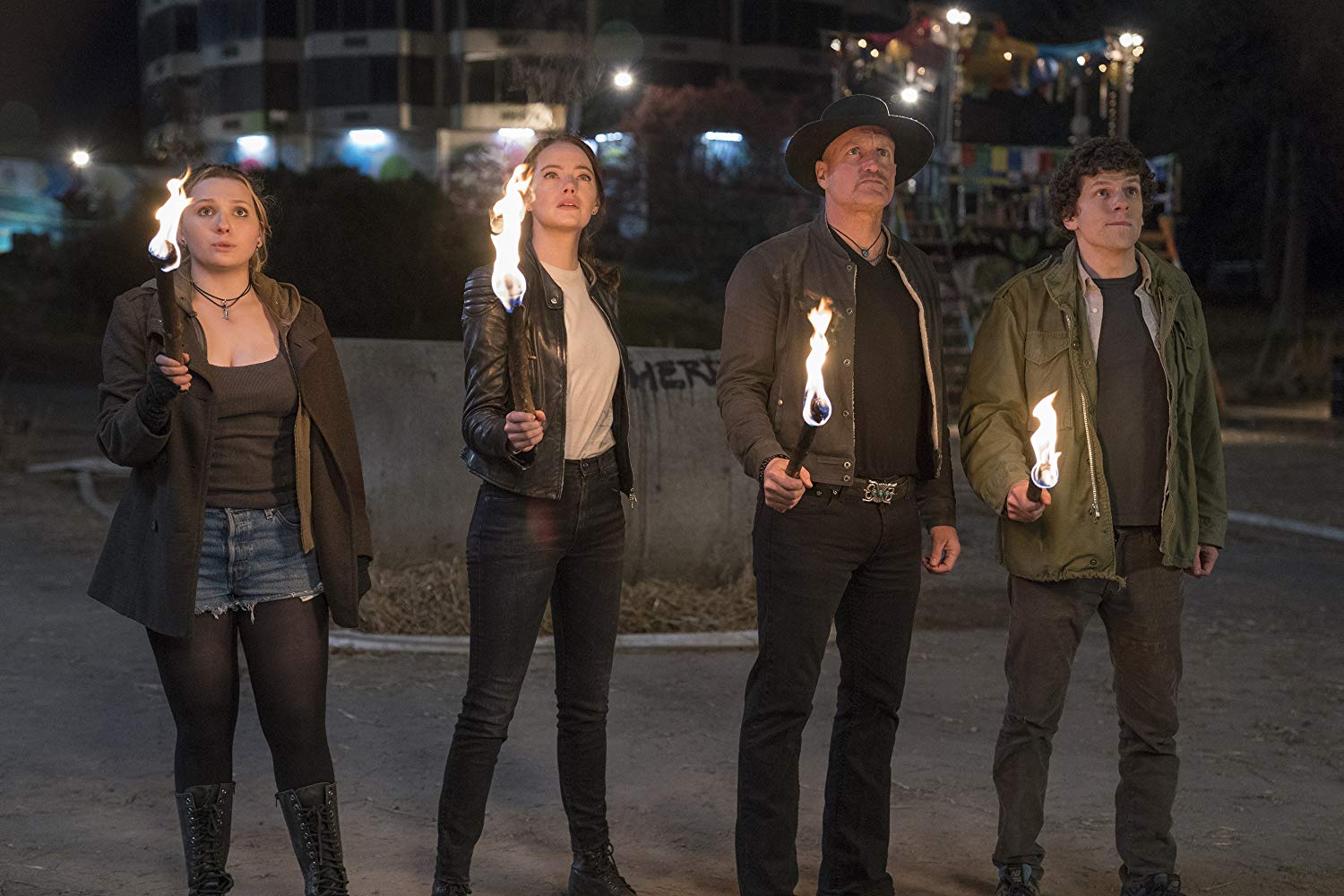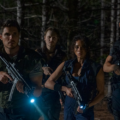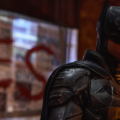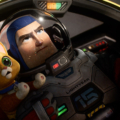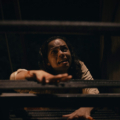It’s been ten years in the making, but Zombieland: Double Tap is finally here. We talk to the director and writers to find out how this sequel will take things up a notch…
It’s hard to believe that it’s been ten years since Zombieland. Back then, it was the little zombie comedy that could, something of an underdog in an overcrowded subgenre that rose above the legions of deeply mediocre Shaun Of The Dead rip-offs with a winning combination of heart, humour and splatter, not to mention an outstanding cast. Watching Woody Harrelson, Jesse Eisenberg, Emma Stone and Abigail Breslin slay the hell out of the undead was an absolute joy, and there was a sincerely endearing story of a ramshackle family coming together that held everything together. Funny, sweet, gory…it was a hit with audiences and critics that quickly became a modern genre classic, and we couldn’t wait for a sequel. But wait we did.
“I think it’s no secret that we would have preferred to have it happen before now, but the stars had to align,” laughs Rhett Reese. “Literally,” deadpans his writing partner Paul Wernick. The two penned the original screenplay and have since gone onto even greater heights of pop culture mega-stardom with the Deadpool movies, but Zombieland has always been their baby and they never gave up on putting a second chapter together.
“There are a lot of moving pieces that had to come together, and we have experience of that,” Reese continues. “Deadpool was a project that took a long time to come together, the original Zombieland took a fair amount of time to come together, and this one broke all records, it’s been a decade. But that said, I think the waiting made it all the sweeter. When the stars finally did align and everybody got excited about the draft and we realised we really did have the whole band together, by that meaning producer, director, writers, stars, everybody, it started to feel like it had to have played out the way it did, in a strange way, and it felt like going back to camp for all the people who went down to Atlanta. It was like a return to camp or a family reunion or a school reunion or something like that. It felt very collegial and fun.”
For the uninitiated, Zombieland began with nervy Columbus (Jesse Eisenberg) teaming up with blowhard badass Tallahassee (Woody Harrelson), with the latter desperately searching for Twinkies as the former reels off his rules for survival. Along the way, they meet Wichita (Emma Stone) and Little Rock (Abigail Breslin), two tough survivors who comfortably outsmart them before they form a makeshift family to face this ruined world together.
“When you have such amazing people as Emma Stone, Jesse Eisenberg, Woody Harrelson and Abigail Breslin, it’s hard not to want to work with them,” director Ruben Fleischer enthuses. “Every movie I’ve done has had an original cast member from Zombieland. 30 Minutes Or Less was with Jesse, Emma was in Gangster Squad and Woody was in Venom. I just loved these people so much and being able to get them back all together at once was kind of a dream come true and they truly are some of the most charismatic and entertaining actors out there so getting them all together is a real joy and a privilege.”
While Fleischer tells us that he was never in any doubt that he wanted to return for a sequel, he tells us that everyone understood the risks involved in rushing in. After all, belated sequels can be a tricky business. For every Blade Runner 2049, there’s a Sin City: A Dame To Kill For, or a 300: Rise Of An Empire (hmm, maybe it’s a Frank Miller thing…). Zombieland’s fandom is a thing to be cherished and nobody wanted to let their audience down.
“We were very, very cautious, the cast especially, in not wanting to make something that wasn’t at least as good as the original,” he remembers. “Woody especially felt a responsibility to audiences that if we were going to do a sequel it had to be at least as good as the original. It’s become such a beloved cult movie and so we all were very demanding and exacting with the script to ensure that we had full confidence in what we were making and that it had the potential to be as good as the first. So it was something that none of us were able or willing or ready to move forward until we truly believed that the script was ready. And that’s in part why it took a while to get the sequel made, because we were just really exacting with the script.”
Reese and Wernick tell us that Fleischer, their co-writer Dave Callaham, the core cast and returning producer Gavin Polone all had a hand in ensuring the screenplay reached the same high standards while keeping that original voice, but it turns out that one very important voice was surprisingly close to home. “Well, Rhett is Columbus,” laughs Wernick. “Talk about a voice that won’t shut up,” laughs Reese. “Paul’s sick of hearing it every day, and God knows I’m sick of hearing the inner voice! But yeah, we created the characters so they’re very much alive for us and always have been. Tallahassee being the id and Columbus being the super ego, the rule-follower versus the rule-breaker and the crazy guy and the careful guy. They’re part of everybody’s personality, everybody has these sides to them. They definitely lived with us. And we were involved in the project in one form or another for many years too, so we would revisit them. Even though the movie wasn’t getting made, we were still tinkering and doing things. So they never left us for long.”
So, the new film picks up 10 years later and our plucky band of heroes are still very much a family but in a slightly swankier location having left the rides and reanimated clowns of Pacific Playland far behind. “Columbus tells [the audience] ‘My friend Tallahassee has a saying, go big or go home, so I decided to find a place where we could go big and go home,’ and then you find them inside the White House living with that as their new safe haven,” explains Fleischer. “Columbus and Wichita sleep in a linking bedroom, their family room is the Oval Office, and they’re all happy together living in a post-apocalyptic version of domestic bliss.”
However, it’s not long before a spanner is thrown in the works of this Presidential family happiness, as a charismatic new arrival lures one of the family away… “Berkeley [played by Now Apocalypse’s Avan Jogia] is a musician, kind of the guy that any father wouldn’t want his daughter falling for, so naturally Little Rock is taken by him,” teases Fleischer. “She ends up going off on her own with him because she’s never had a chance to be around people her own age or have any kind of romance. So like any late teens early 20s girl she’s just looking to get away from her parents and spread her wings.”
And so, Columbus, Tallahassee and Wichita head off across the country to find the wayward teen and bring her back. Little Rock’s desperation to escape her family and have her own adventures is just one of the ways in which the film capitalises on the ten year gap between the films. While these are the same characters that we know and love from the original, they’ve all grown in the interim and the filmmakers tell us that they were very excited about exploring how a decade spent living in close proximity in a zombie-ridden apocalypse would have affected this group.
“I think that actually makes it more interesting because it’s rare that you get to have a sequel that comes ten years later, and especially in a post-apocalyptic scenario, a lot has changed,” explains Fleischer. “Like the landscape, the zombies themselves have evolved and then obviously the dynamics among the characters have changed a lot.”
“We originally wrote a Zombieland draft right after the first movie and it was intended to happen right after the first movie,” adds Reese. “And chronologically, so Little Rock, Abigail Breslin’s character, was the same age and then as we moved through the decade, unable to make the movie for one reason or another, we had to really place ourselves in the shoes of those characters. We couldn’t write Abigail as a 13-year-old girl anymore, then she became a 15-year-old girl, then a 19-year-old girl. So it forced us to think about how Zombieland itself changed during that time and see how the characters did. You get the sense when you come in and meet our family that there’s status there. They are a happy family but a dysfunctional family and there are conflicts among them that end up essentially driving them apart for a little bit and they have to learn the lesson that they really do belong together and come back together. That’s really the meat of the film.”
For Fleischer, the gap also gave him the opportunity to imagine a landscape even deeper in Zombieland than we’d seen in the first. This was no longer an apocalypse that happened about an hour ago, this is very much their world now. “I really wanted the landscape to look different ten years later,” he explains. “The first movie took place pretty much immediately after the outbreak, [but now] nature would really start to come back, so even the White House is covered with vines and overgrown, you’re just seeing it in a way that you’ve never seen it before, so that was exciting to be able to create a world that looks very different to our present.”
“We also played with the idea that pop culture and references and such are frozen in time as of 2009, so we play on that a little bit,” adds Reese. “We have our characters only referencing stuff that happened pre-2009 and lamenting the fact that we’re stuck with the same vocabulary, we never got any new movies, we never got any new vocabulary so we’re stuck with the old words, the old things we used to say. We did some inside jokes about… they’re envisaging what the world might have looked like had it stayed alive. Of course we know how it actually looks, but we get to play with that a little bit, comically, the idea that they’re speculating about what the world might have looked like in ten years and sometimes they’re dead on and sometimes they’re not.”
While the pop culture references may have stayed frozen in time, the filmmakers knew that one key element needed to be punched up for the sequel. Yes, that’s right, we’re talking about Zombie Kill Of The Week. “It’s a signature of the first film so we knew that we had to take it to the next level so we’ve introduced the zombie kills of the year and have some really fun extreme zombie kills,” grins Fleischer.
However, as much as we’re looking forward to seeing Woody Harrelson mow down a field of zombies with a wheat thresher, there’s a clear understanding here that it wasn’t just the kills that made the thrills. At the heart of Zombieland is, well, a heart, with the first movie delivering some surprising moments in amongst the gags and the mayhem.
“That’s kind of our secret sauce, the heart, right?” Wernick tells us. “You think you’re watching a zombie movie but really it’s a romantic comedy, or you think you’re watching a superhero movie, and really it’s a love story. It’s a delicate balance, knowing when to play the laughs and knowing when to play the heart and the emotion and the action. Life isn’t one tone, I think is the best way we describe it. You’re laughing one moment and you’re crying the next in real life, so that mixing of tones really grounds the movie in reality because people know what that’s like.
“In the first movie Woody is telling the story of his dead son and they’re playing Monopoly with real money and they’re by the fireplace and Woody’s crying and he dabs his eyes with real $100 bills from the Monopoly game and says ‘I haven’t cried like that since Titanic’ and it gets… here we are, we’ve taken this very emotional story of Tallahassee telling the story of his dead son and it’s emotional and it’s sad and then we turn it on its head and subvert that moment with that comedy and we get a huge laugh and it keeps audiences on the edge of their seat. They’re along for the journey and they feel what our characters are feeling as they’re feeling it. So I think that’s a long way of saying we don’t really know how we do it, in the sense that we just write it from the heart and that comes out on screen.”
It’s perfectly natural to have some nerves about a belated sequel and we’ve discussed them in great length here, but it’s so heartening that the filmmakers know how special their first film was. “I think ultimately it’s about the characters more than anything,” Reese muses. “You love the people you’re watching, you want to return to them. For a movie that is airing sometimes on television that you’ve seen before, it’s like putting on a comfy sweater, and that was one of the reasons we wanted to make a sequel, we all wanted to put on that comfy sweater again. It’s about relatable three-dimensional people. We’re not really relying on pyrotechnics. We’re not even relying on that much on zombies. We are, they’re certainly in it, but we’ve always felt that zombies are gravy and that if we get the relationships right, and the scenes where they’re driving around in a car talking to each other, arguing, if we get those scenes right then those will be timeless.”
This article first appeared in SciFiNow issue 163.
Zombieland: Double Tap is in cinemas from 18 October 2019. Get all the latest sci-fi news with every issue of SciFiNow.
